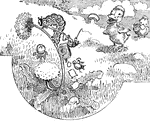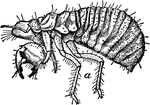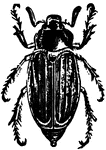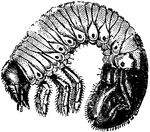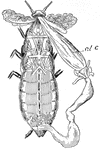
Ox Botfly
"Ox Botfly. a.-- larva, full grown, natural size; b,-- pupa; c.-- perfect insect. Botfly, Gadfly, and…
Bruchus Pisi
Pictured are the beetle of the natural size (a), and enlarged (b), and a pea (c) in which the hole of…

Stink Bug
Also known as Stiretrus anchorago. This bug is predatory of the larvae of the Mexican bean beetle and…
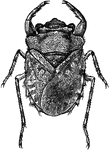
Dorsal View of Toad Bug
Galgulus oculatus is a true bug species in the Gelastocoridae family of toad bugs.

Giant Buprestis
"The Giant Buprestis, B. gigantea of guiana, is two inches long, and its body is of a green…
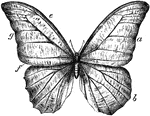
Butterfly
"Shows a butterfly with comparatively very large wings. The nervures are seen to be a great advantage…
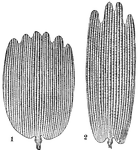
Scales from the Wings of a Butterfly
"Scales from the wings of a butterfly, Vanessa antiopa, highly magnified. 1. from border of anterior…

Apollo Butterfly
"The Apollo butterfly, P. Apollo, is found in the damp meadows of the high Alps; the wings…
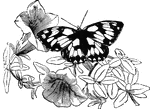
Half-Mourning Butterfly
"The Galatea Butterfly, P. Galatea, A Euoprean species, called The Half-Mourning Butterfly,…

Large White Cabbage Butterfly
Also known as Pieris brassicae. It is commonly found throughout Europe, Asia, and north Africa. The…

Large White Cabbage Butterfly
Large white cabbage butterflies have large wings that are covered with small scales. The mouth is not…

Larva and Pupa of a Large White Cabbage Butterfly
Also known as Pieris brassicae. An image of the larva and pupa of the large white cabbage butterfly.
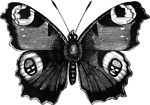
Peacock Butterfly
"The Peacock-butterfly, V. Io, has the edges of the wings denticulated; above they are of a…
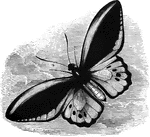
Priam Butterfly
"The Priam butterfly, Papilio priamus, is a native of the Eastern Archipelago; its wings are…
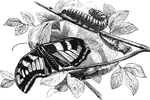
Stages of Development of a Butterfly
"Butterfly, Grub or Caterpillar, and Pupa or Chrysalis" — Goodrich, 1859
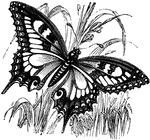
Swallowtail Butterfly
The swallowtail butterfly (Papilio machaon) is a large colorful butterfly with atleast 550 species.
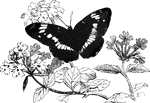
Sybil Butterfly
"The Sybil Butterfly, P. Sybilla, sometimes called the Mourning Butterfly, is a common…
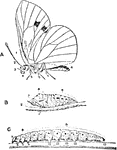
Three Stages of Cabbage Buterfly
A sequenced illustration of the cabbage butterfly undergoing metamorphosis. The butterfly starts out…
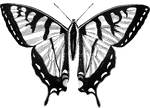
Troilus Butterfly
"The Troilus Butterfly, Papilio Troilus, is a superb insect, the wings denticulated, black,…
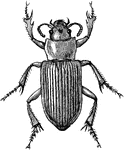
Caraboid Beetle
"Geopinus incrassatus. GEOPINUS. A genus of caraboid beetles, of the subfamily Harpalinae, having the…
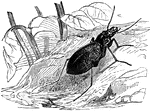
Blue Carabus
"The Blue Carabus, C. cyaneus, is an inch and a quarter long, the body oval, flat, and above…

Golden Carabus and Cock-Chafer
"In illustration of the savageness of this race, the author of the "Jardin des Plantes" tells us of…
!["The Inquisitor Carabus, <em>C. inquisitor</em>, has the same form and manner as the [Sycophant Carabus]: the body is an inch long, and of a blackish-green color." — Goodrich, 1859](https://etc.usf.edu/clipart/14600/14649/inquiscarabs_14649_mth.gif)
Inquisitor Carabus
"The Inquisitor Carabus, C. inquisitor, has the same form and manner as the [Sycophant Carabus]:…

Nest of the Carder Bee
"The elevation of the dome, which is all built from the interior, is from four to six inches above the…

Cassida gibbosa
"The Cassida gibbosa of Brazil, three quarters of an inch long, is one of the larger species…

Large Cabbage Butterfly Caterpillar
Caterpillar, larvae of the butterfly, are harmful to plants. These caterpillars sucker feet on the hinder…

Processionary Caterpillars
"If the guide stops a moment all the followers halt; if he continues the route, they all hasten after…
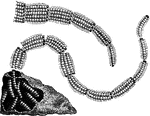
Processionary Caterpillars
"If the guide stops a moment all the followers halt; if he continues the route, they all hasten after…
Double-Toothed Prominent Caterpillar
The caterpillar stage of the double-toothed prominent (Nerice bidentata) showing its serrated back.
Centiped
The common hundred-legged worm. Its body is divided into a number of similar joints, and each joint…

Giant Centipede
"A Centipede is a worm having a long slender, depressed body, protected by coriaceous plates, 21 pairs…
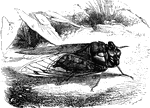
Cicada
"In America the cicadas have the general name of Harvest-flies; they are also often improperly…

Head of Cicada
A cicada is an insect of the order Hemiptera, suborder Auchenorrhyncha, in the superfamily Cicadoidea,…
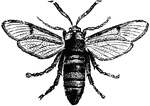
Clear Wing Moth
When clear wing moths are larvae they live in burrows, in the roots and stems of many plants, and often…

Cochineal
An illustration of Cochineal living on cactus. Cochineal is the name of both crimson or carmine dye…

Cochineal (Female)
An illustration of a female Cochineal. Cochineal is the name of both crimson or carmine dye and the…
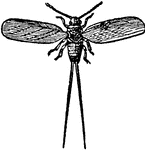
Cochineal (Male)
An illustration of a male Cochineal. Cochineal is the name of both crimson or carmine dye and the cochineal…
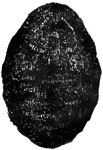
Female Cochineal Insect
"Cochineal is a dye-stuff employed in dyeing scarlet and crimson; consists of the bodies of the femals…

Male Cochineal Insect
"Cochineal is a dye-stuff employed in dyeing scarlet and crimson; consists of the bodies of the femals…
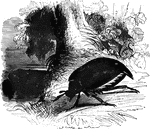
Cockchafer
"In the common European Cock-Chafer, Melolontha vulgaris, they are of considerable length,…

Cockchafer
An illustration of a cockchafer. The cockchafer (colloquially called may bug, billy witch, or spang…
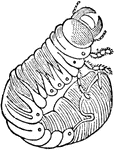
Cockchafer Larva
An illustration of a full grown cockchafer larva. The cockchafer (colloquially called may bug, billy…

Cockchafer Pupa
An illustration of a cockchafer pupa. The cockchafer (colloquially called may bug, billy witch, or spang…







